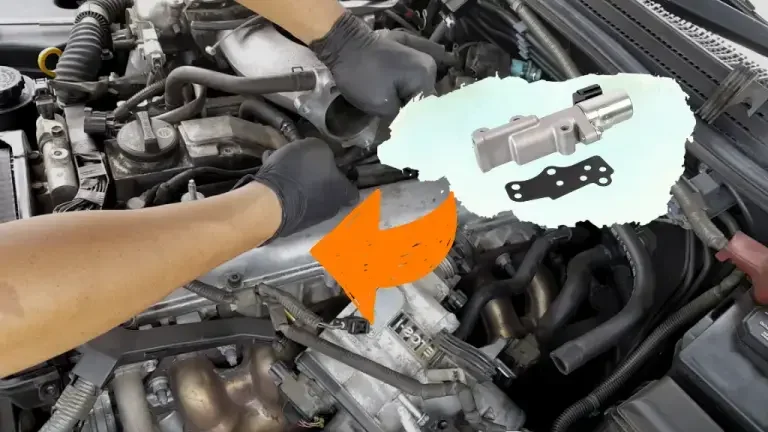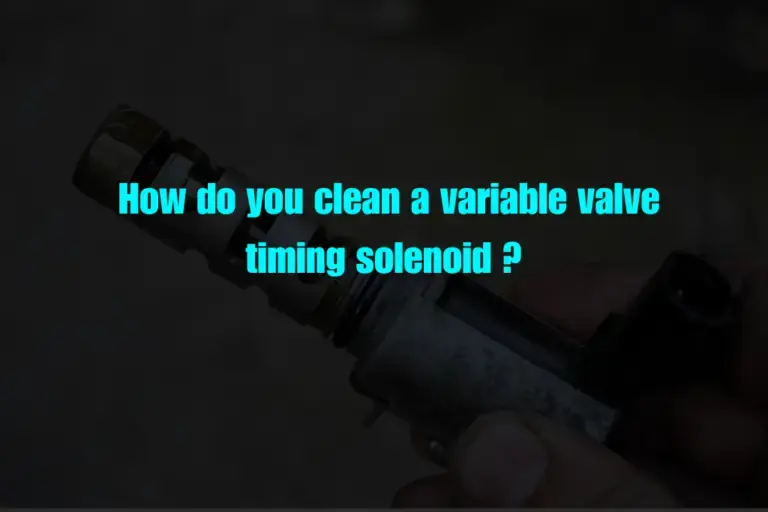Today, most cars that run on gas come with a special feature that allows the valves’ timings to be tweaked according to the RPM, engine load, road conditions and other factors. The most commonly found systems use VVT solenoids or Variable Valve Timing Solenoids.
To clean it, locate the solenoid, disconnect it from the engine, remove dirt and grime with a cleaner and cloth, check for damage, and then reconnect the engine safely before testing its operation.
In this article, we will share simple steps on how to clean a VVT or variable valve timing solenoid.
What is a VVT Solenoid?
A Variable Valve Timing (VVT) Solenoid is a crucial component in modern car engines that allows the efficient control of the engine’s valve opening and closing times.

This timing adjustment optimizes engine performance, fuel efficiency, and emissions. Essentially, the VVT solenoid helps the engine adapt to different driving conditions by adjusting the valves’ opening and closing times.
Why You Should Clean Variable Valve Timing Solenoid?
The variable valve timing solenoid is like a traffic controller for construction machinery engines. It helps adjust when valves open and close to make the engine work better and use fuel efficiently.
1. Understanding the VVT Solenoid: Think of the variable valve timing solenoid valve as a traffic controller for construction machinery engines. It adjusts when valves open and close to make the engine work better and use fuel efficiently.
2. Importance of Cleaning: Over time, dirt and gunk can build up on the solenoid, causing problems like slow or incorrect actions. Regular cleaning is crucial to maintain optimal performance.
3. Effect of Dirt Build-up: When the solenoid gets clogged up, it’s like having a door that won’t shut properly, leading to wasted fuel. Cleaning it helps the engine work smoothly and use less fuel, which is beneficial for the environment.
4. Preventing Engine Damage: If the solenoid remains dirty or stuck, it can disrupt the engine’s operation and even cause damage. Regular cleaning prevents such issues and ensures the engine runs well.
5. Lifespan: Regular cleaning prevents more dirt from piling up and reduces the risk of the solenoid breaking due to dirt accumulation. This prolongs the solenoid’s lifespan, saving you money on repairs in the long run.
Why Variable Valve Timing Solenoid Gets Clogged?

5 Simple Steps To Clean Variable Valve Timing Solenoid
Cleaning your car engine’s Variable Valve Timing (VVT) solenoid in regular intervals to ensure your car’s engine works smoothly. Here’s how you can do it:
Step 1: Getting Ready

- Parking and Safety: Park the machine safely, apply the handbrake, and make sure the engine doesn’t start accidentally.
- Find the Valve: Check your car manual to find where the solenoid valve is. It’s usually near the top of the engine.
- Tools and Cleaners: Get the right tools like wrenches and screwdrivers, and cleaners suitable for your machine.
Step 2: Removing The Valve

- Disconnecting: Before taking the valve out, disconnect the wire attached to it carefully.
- Unscrewing: Use a wrench to gently unscrew the bolts holding the valve in place.
- Removing: Once the bolts are off, carefully take out the valve. It might be stuck, so wiggle it gently to get it out.
Step 3: Cleaning The Valve

- Cleaning the Valve: Use a cleaning pipe and an air pressure gun to clean the valve well. Be careful not to get cleaner into the electrical parts.
- Cleaning Seat and Parts: Also, clean where the valve sits and any other parts connected to it, making sure everything is free of dirt and deposits.
- Check the O-ring: Clean the rubber on the valve for any damage. If it’s worn out, replace it with a new one.
Step 4: Putting Back The Valve

- Installing the Valve: Put the clean valve back and hand-tighten the bolts.
- Tightening: Use a torque wrench to make sure the bolts are tightened properly,
- Reconnecting: Plug the wire you disconnected earlier back into the valve.
Step 5: Testing
- Starting the Engine: Turn the power back on, start the engine, and watch carefully to see if the cleaned valve is working as it should.
- Sealing Ability: Once the valve is closed, it should completely stop the flow in the intended direction. Listen for leaks or drips.
- Flow Rate: If the valve controls the flow of a liquid or gas, observe if the flow rate is consistent and matches expectations when the valve is open.
- Pressure Regulation: If the valve regulates pressure, measure the pressure on both sides of the valve to ensure it’s within the desired range.
Signs Your Variable Valve Timing Solenoid Needs Cleaning
- Rough Engine Performance: Your engine may struggle during acceleration, indicating that the VVT valve isn’t working as it should.
- Check Engine Light: If the check engine light on your dashboard comes on, it could be a signal that something’s wrong with the VVT system.
- Decreased Fuel Efficiency: A dirty VVT valve may cause your engine to use more fuel than necessary, resulting in a noticeable drop in fuel efficiency.
- Unusual Engine Noises: Listen for strange noises coming from your engine, such as ticking or rattling. These noises, particularly during acceleration or deceleration, might indicate problems with the VVT valve.
- Engine Misfires: If engine misfires, it means that one or more cylinders aren’t firing properly. This can lead to rough running, vibrations, or even popping sounds, all of which may be caused by a dirty or malfunctioning VVT valve.






